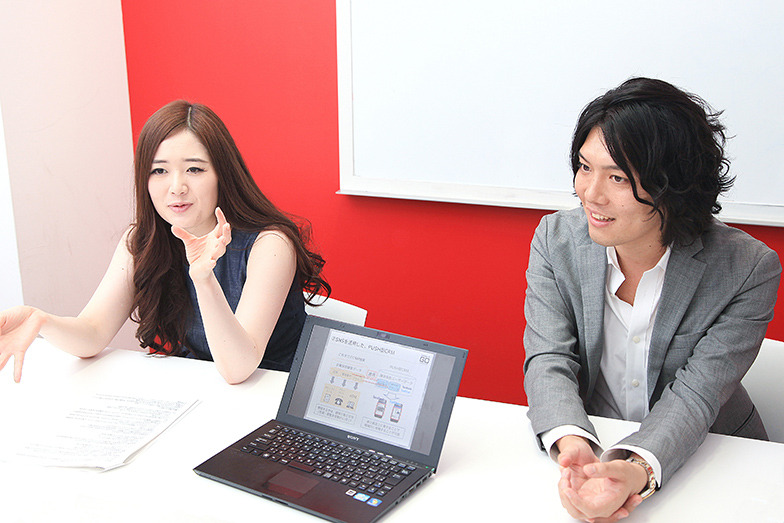Following #3, we spoke with Mariko Sonoda of Nextedge Dentsu Inc. and Yuhei Hatano of Dentsu Inc. about video ads when running "Facebook Ads," integration with customer management systems, methods for verifying effectiveness, and actual operational case studies. They also shared their thoughts on the "future" the Facebook platform is likely aiming for.
*Note: Nexedge Dentsu Inc. became "Dentsu Digital Inc." effective July 1, 2016.

■Why are videos gaining traction on Facebook?
--We now frequently see video ads on Facebook. What kind of effects can be expected from video ads?
Hatano: This might be a bit of a tangent, but I hear founder Mark Zuckerberg doesn't use computers much. He's mostly on his smartphone. I've heard his thinking is, "Since users are on smartphones, let's do our work on smartphones too." Following the same logic, Zuckerberg's idea is, "Since there are users interested in video, let's focus on video too."
The key point is that Facebook provides video as a delivery method, alongside static images, specifically to meet user demand. It's not about forcing video on everyone. Instead, it shows more video to users who respond to video, and more static images to those who respond to static content. Or, for specific content, it shows that content in both formats to users who respond to either.
This applies equally to ads and news feed articles. If something interests you, watching a longer video isn't a chore, right? Facebook can leverage personal data to deliver highly relevant articles and ads with great precision. Compared to static images or text, videos carry more information and have greater impact. Therefore, for interested users, video ads are an effective tool.
Sonoda: Video ads are positioned as a complementary medium to TV commercials for boosting reach and awareness. For example, they're used for ongoing communication during periods when TV commercials aren't running, or for distributing longer-form videos that can't be fully conveyed within a 15-second commercial spot.

■Reactivating Dormant Customers with Custom Audiences
--Facebook offers a feature called "Custom Audiences." When a company uploads customer data from outside Facebook, it can deliver ads to users within that data who also use Facebook. What are effective ways to use this?
Sonoda: I believe there are two main ways to use Custom Audiences.
One is acquiring potential customers more efficiently. First, create a target list for Custom Audiences based on website visit history. When building this list, targeting by specific touchpoints—like "people who accessed the application form but didn't convert"—allows for more personalized ad delivery. Since individuals who previously accessed the application form have shown interest, providing the right ad should significantly increase the likelihood of conversion.
The second is the ability to reactivate dormant customers with high precision—customers your clients haven't been able to reach. You create a target list using data like dormant customers' email addresses or phone numbers and deliver ads to them.
For example, it's not uncommon for users to be registered on an online shopping site but not subscribed to its email newsletter. One fashion e-commerce site had 10 million online members, but only 2 to 3 million were newsletter subscribers.
Meanwhile, email newsletter open rates from companies generally range from 10% to 20% and show a declining trend year by year. This is likely significantly influenced by the shift in communication channels from email newsletters to platforms like Facebook and LINE. For B2C clients, the email address matching rate for Custom Audiences is generally said to be around 20% to 30%. By effectively utilizing "Custom Audiences," you can deliver sales information directly to the Facebook News Feed of dormant customers who are only registered on the site, just as you would send it to newsletter subscribers.
Additionally, the "Lookalike Audience" delivery method is effective. This feature allows you to deliver ads to users similar to those in your own data, based on Facebook's vast data holdings. For example, when delivering cosmetics ads, you can perform "lookalike expansion" based on your own purchaser list to target people with similar attributes and interests, or those who have reacted to similar products in the past.
Furthermore, by creating a target list based on smartphone app usage patterns, you can deliver ads to users who haven't used the app much after installation, encouraging them to engage.
——I imagine many companies are sensitive about personal information. How is the information managed?
Hatano: Personal information is hashed (irreversibly encrypted) on the customer's computer, that is, before the information is passed to Facebook. It is then collated with similarly hashed personal information on Facebook, so security is taken into consideration. As you say, many clients are concerned about uploading personal information, so we provide thorough explanations.
In implementing this measure, we often struggle to explain personal information management, but Facebook's Custom Audiences has been certified for information management security by PricewaterhouseCoopers, a global auditing firm. Perhaps because of this, we are seeing an increase in use cases not only overseas but also in Japan, where security is likely to be the strictest, such as by financial clients like banks.

■Combining Facebook Ads and Salesforce
-- "Custom Audiences" seems to be connected to CRM.
Hatano: Our team handles both acquisition (new customer acquisition) and CRM end-to-end, so recently, along with placing ads on Facebook, we've been seeing more cases where we propose a set package that includes the introduction and design of cloud-based customer management applications such as Salesforce and Marketo.
This ties into the idea that "Facebook isn't just an advertising platform." Facebook has a program called Marketing Partners. Services like Salesforce are part of this ecosystem, meaning they have the infrastructure to seamlessly transfer information via API at any time. Leveraging this ecosystem effectively allows for efficient and high-performing CRM strategies. Let's use the example of customers from that fashion e-commerce site mentioned earlier.
Even among registered users, someone who signed up today has different purchase motivation compared to someone who signed up a week ago or a month ago. Furthermore, even among those who signed up a month ago, motivation differs between users who make regular weekly purchases and those who haven't bought anything at all.
Using Salesforce's customer management application allows you to categorize and manage this customer information. By passing this data to Facebook for each category, you can easily implement precise ad delivery.

■Evaluating Facebook Ad Effectiveness
--Please explain Facebook's new delivery method, "oCPM delivery," and how its effectiveness is verified.
Sonoda: "oCPM delivery" automatically delivers ads to the optimal users based on the set advertising objective. The key point for effectiveness verification is reviewing the granularity of each element: the "ad sets" (which deliver multiple ad variations to the set target audience) and the created "creatives."
Regarding the initial reach and impression volume when launching an ad set: Facebook believes "machine learning should optimize delivery, and the users who respond are the true target audience." Therefore, in the initial design phase, avoid overly restrictive targeting and set a broader reach. For impression volume, Facebook imposes a cap on how many times an ad can be shown to a single person, so the reach and budget settings naturally determine the impression volume.
First, run the ads for about 1-2 weeks with a broad reach and a fixed exposure volume to evaluate effectiveness.
For clients tracking purchases or sign-ups, we review the ad set content based on conversion rates and CPA performance. For budget allocation, we shift budget toward ads with better acquisition efficiency based on CPA. At this stage, we also reference demographic information like gender and age, as well as device performance data such as whether most access comes from PCs or smartphones.
For creatives, we evaluate effectiveness using impressions (number of times displayed) and reach (number of people who saw it) as metrics. For example, if there are Ad Sets 1, 2, and 3, we assign Creatives A, B, and C to each.
Since Facebook's algorithm selects which ads to display, there can be significant differences in the ads shown. Ad Set 1 might perform well with Creative A, while Ad Set 2 might only perform poorly with Creative C. We evaluate which creatives to keep and which to discontinue roughly once a week. Additionally, we proactively add new creatives that incorporate seasonality to prevent audience fatigue.

■Facebook's Potential to Become a Foundation for Society's Daily Life
--Finally, could you share your thoughts on the future potential of Facebook advertising?
Hatano: No other platform possesses such a vast amount of personal data. Since users must log in to use it, Facebook will likely remain a top runner alongside Google in cross-device measurement.
Furthermore, Facebook's strength lies in its ownership of assets like Instagram, Oculus VR (developer of the Oculus Rift virtual reality headset), Parse (a foundational tool for app messaging), and wit.ai (an open-source natural language processing platform).
For instance, if Instagram and Facebook integrate their data more fully, they could potentially capture users with different preferences than typical Facebook users. Furthermore, leveraging Oculus Rift technology, virtual reality experiences might appear in the news feed, following static images and videos. But what feels most promising is the language analysis using wit.ai. Utilizing this could mean capturing not just online behavior, but real-world actions too.
Ultimately, it could transcend being merely an online communication platform or advertising medium, potentially becoming a foundational part of consumers' daily lives. If that happens, it would hold vast amounts of data tied to individuals, encompassing not just online but also offline actions. This makes it crucial to fully grasp this from an omnichannel marketing perspective.
Future marketing will be driven by the combination of "Technology × Ideas." While the US and UK remain ahead in pure technology, our overseas headquarters, Dentsu Inc. Aegis Network, established through the acquisition of UK-based Aegis Group, positions us to catch up faster than any other Japanese advertising agency. Conversely, by sharing our insights globally, we can jointly pioneer even more advanced knowledge on a worldwide scale.
Above all, we possess the capability to consider how to leverage the information and insights gained in this way not only for clients' digital advertising but for their entire marketing strategy. We believe our unique strength lies in being able to provide both.









